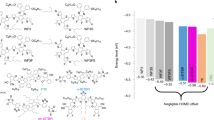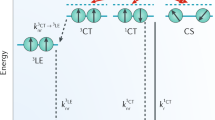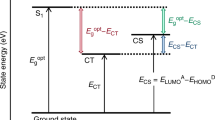Abstract
The use of non-fullerene acceptors (NFAs) in organic solar cells has led to power conversion efficiencies as high as 18%1. However, organic solar cells are still less efficient than inorganic solar cells, which typically have power conversion efficiencies of more than 20%2. A key reason for this difference is that organic solar cells have low open-circuit voltages relative to their optical bandgaps3, owing to non-radiative recombination4. For organic solar cells to compete with inorganic solar cells in terms of efficiency, non-radiative loss pathways must be identified and suppressed. Here we show that in most organic solar cells that use NFAs, the majority of charge recombination under open-circuit conditions proceeds via the formation of non-emissive NFA triplet excitons; in the benchmark PM6:Y6 blend5, this fraction reaches 90%, reducing the open-circuit voltage by 60 mV. We prevent recombination via this non-radiative channel by engineering substantial hybridization between the NFA triplet excitons and the spin-triplet charge-transfer excitons. Modelling suggests that the rate of back charge transfer from spin-triplet charge-transfer excitons to molecular triplet excitons may be reduced by an order of magnitude, enabling re-dissociation of the spin-triplet charge-transfer exciton. We demonstrate NFA systems in which the formation of triplet excitons is suppressed. This work thus provides a design pathway for organic solar cells with power conversion efficiencies of 20% or more.
This is a preview of subscription content, access via your institution
Access options
Access Nature and 54 other Nature Portfolio journals
Get Nature+, our best-value online-access subscription
$29.99 / 30 days
cancel any time
Subscribe to this journal
Receive 51 print issues and online access
$199.00 per year
only $3.90 per issue
Buy this article
- Purchase on Springer Link
- Instant access to full article PDF
Prices may be subject to local taxes which are calculated during checkout



Similar content being viewed by others
Data availability
The data that support the plots within this paper and other findings of this study are available at the University of Cambridge Repository (https://doi.org/10.17863/CAM.75316).
References
Liu, Q. et al. 18% efficiency organic solar cells. Sci. Bull. 65, 272–275 (2020).
Green, M. A. et al. Solar cell efficiency tables (version 55). Prog. Photovolt. Res. Appl. 28, 3–15 (2020).
Liu, S. et al. High-efficiency organic solar cells with low non-radiative recombination loss and low energetic disorder. Nat. Photon. 14, 300–305 (2020).
Menke, S. M., Ran, N. A., Bazan, G. C. & Friend, R. H. Understanding energy loss in organic solar cells: toward a new efficiency regime. Joule 2, 25–35 (2018).
Yuan, J. et al. Single-junction organic solar cell with over 15% efficiency using fused-ring acceptor with electron-deficient core. Joule 3, 1140–1151 (2019).
Shockley, W. & Queisser, H. J. Detailed balance limit of efficiency of p–n junction solar cells. J. Appl. Phys. 32, 510–519 (1961).
Ross, R. T. Some thermodynamics of photochemical systems. J. Chem. Phys. 46, 4590–4593 (1967).
Rau, U. Reciprocity relation between photovoltaic quantum efficiency and electroluminescent emission of solar cells. Phys. Rev. B 76, 085303 (2007).
Lee, J. et al. Design of nonfullerene acceptors with near-infrared light absorption capabilities. Adv. Energy Mater. 8, 1801209 (2018).
Cui, Y. et al. Over 16% efficiency organic photovoltaic cells enabled by a chlorinated acceptor with increased open-circuit voltages. Nat. Commun. 10, 2515 (2019).
Qian, D. et al. Design rules for minimizing voltage losses in high-efficiency organic solar cells. Nat. Mater. 17, 703–709 (2018).
Zhou, Z. et al. Subtle molecular tailoring induces significant morphology optimization enabling over 16% efficiency organic solar cells with efficient charge generation. Adv. Mater. 32, 1906324 (2020).
Li, S., Li, C., Shi, M. & Chen, H. New phase for organic solar cell research: emergence of Y-series electron acceptors and their perspectives. ACS Energy Lett. 5, 1554–1567 (2020).
Yuan, J. et al. Reducing voltage losses in the A-DA′D-A acceptor-based organic solar cells. Chem 6, 2147–2161 (2020).
Vandewal, K., Mertens, S., Benduhn, J. & Liu, Q. The cost of converting excitons into free charge carriers in organic solar cells. J. Phys. Chem. Lett. 11, 129–135 (2020).
Geffroy, B., le Roy, P. & Prat, C. Organic light-emitting diode (OLED) technology: materials, devices and display technologies. Polym. Int. 55, 572–582 (2006).
Classen, A. et al. The role of exciton lifetime for charge generation in organic solar cells at negligible energy-level offsets. Nat. Energy 5, 711–719 (2020).
Eisner, F. D. et al. Hybridization of local exciton and charge-transfer states reduces nonradiative voltage losses in organic solar cells. J. Am. Chem. Soc. 141, 6362–6374 (2019).
Chen, X.-K., Coropceanu, V. & Brédas, J.-L. Assessing the nature of the charge-transfer electronic states in organic solar cells. Nat. Commun. 9, 5295 (2018).
Wang, J., Chepelianskii, A., Gao, F. & Greenham, N. C. Control of exciton spin statistics through spin polarization in organic optoelectronic devices. Nat. Commun. 3, 1191 (2012).
Chen, X.-K., Wang, T. & Brédas, J.-L. Suppressing energy loss due to triplet exciton formation in organic solar cells: the role of chemical structures and molecular packing. Adv. Energy Mater. 7, 1602713 (2017).
Rao, A. et al. The role of spin in the kinetic control of recombination in organic photovoltaics. Nature 500, 435–439 (2013).
Kraffert, F. et al. Charge separation in PCPDTBT:PCBM blends from an EPR perspective. J. Phys. Chem. C 118, 28482–28493 (2014).
Köhler, A. & Beljonne, D. The singlet–triplet exchange energy in conjugated polymers. Adv. Funct. Mater. 14, 11–18 (2004).
Hodgkiss, J. M. et al. Exciton-charge annihilation in organic semiconductor films. Adv. Funct. Mater. 22, 1567–1577 (2012).
Benduhn, J. et al. Impact of triplet excited states on the open-circuit voltage of organic solar cells. Adv. Energy Mater. 8, 1800451 (2018).
Cohen, A. E. Nanomagnetic control of intersystem crossing. J. Phys. Chem. A 113, 11084–11092 (2009).
Shoaee, S. et al. Decoding charge recombination through charge generation in organic solar cells. Sol. RRL 3, 1900184 (2019).
Dimitrov, S. D. et al. Polaron pair mediated triplet generation in polymer/fullerene blends. Nat. Commun. 6, 6501 (2015)
Salvadori, E. et al. Ultra-fast spin-mixing in a diketopyrrolopyrrole monomer/fullerene blend charge transfer state. J. Mater. Chem. A 5, 24335–24343 (2017).
Menke, S. M. et al. Limits for recombination in a low energy loss organic heterojunction. ACS Nano 10, 10736–10744 (2016).
Xue, L. et al. Side chain engineering on medium bandgap copolymers to suppress triplet formation for high-efficiency polymer solar cells. Adv. Mater. 29, 1703344 (2017).
Chow, P. C. Y., Gélinas, S., Rao, A. & Friend, R. H. Quantitative bimolecular recombination in organic photovoltaics through triplet exciton formation. J. Am. Chem. Soc. 136, 3424–3429 (2014).
Di Nuzzo, D. et al. Improved film morphology reduces charge carrier recombination into the triplet excited state in a small bandgap polymer-fullerene photovoltaic cell. Adv. Mater. 22, 4321–4324 (2010).
Karuthedath, S. et al. Buildup of triplet-state population in operating TQ1:PC71BM devices does not limit their performance. J. Phys. Chem. Lett. 11, 2838–2845 (2020).
Wang, R. et al. Charge separation from an intra-moiety intermediate state in the high-performance PM6:Y6 organic photovoltaic blend. J. Am. Chem. Soc. 142, 12751–12759 (2020).
Gelinas, S. et al. Ultrafast long-range charge separation in organic semiconductor photovoltaic diodes. Science 343, 512–516 (2014).
Jakowetz, A. C. et al. Visualizing excitations at buried heterojunctions in organic semiconductor blends. Nat. Mater. 16, 551–557 (2017).
Menke, S. M. et al. Order enables efficient electron-hole separation at an organic heterojunction with a small energy loss. Nat. Commun. 9, 277 (2018).
Burke, T. M., Sweetnam, S., Vandewal, K. & McGehee, M. D. Beyond langevin recombination: how equilibrium between free carriers and charge transfer states determines the open-circuit voltage of organic solar cells. Adv. Energy Mater. 5, 1500123 (2015).
Hosseini, S. M. et al. Putting order into PM6:Y6 solar cells to reduce the Langevin recombination in 400 nm thick junction. Sol. RRL 4, 2000498 (2020).
Karki, A. et al. Understanding the high performance of over 15% efficiency in single-junction bulk heterojunction organic solar cells. Adv. Mater. 31, 1903868 (2019).
Niklas, J. et al. Highly-efficient charge separation and polaron delocalization in polymer-fullerene bulk-heterojunctions: a comparative multi-frequency EPR and DFT study. Phys. Chem. Chem. Phys. 15, 9562–9574 (2013).
Richert, S., Tait, C. E. & Timmel, C. R. Delocalisation of photoexcited triplet states probed by transient EPR and hyperfine spectroscopy. J. Magn. Reson. 280, 103–116 (2017).
Thomson, S. A. J. et al. Charge separation and triplet exciton formation pathways in small molecule solar cells as studied by time-resolved EPR spectroscopy. J. Phys. Chem. C 121, 22707–22719 (2017).
Hintze, C., Steiner, U. E. & Drescher, M. Photoexcited triplet state kinetics studied by electron paramagnetic resonance spectroscopy. ChemPhysChem 18, 6–16 (2017).
Benduhn, J. et al. Intrinsic non-radiative voltage losses in fullerene-based organic solar cells. Nat. Energy 2, 17053 (2017).
Kubas, A. et al. Electronic couplings for molecular charge transfer: benchmarking CDFT, FODFT and FODFTB against high-level ab initio calculations. II. Phys. Chem. Chem. Phys. 17, 14342–14354 (2015).
Chang, W. et al. Spin-dependent charge transfer state design rules in organic photovoltaics. Nat. Commun. 6, 6415 (2015).
Street, R. A., Song, K. W., Northrup, J. E. & Cowan, S. Photoconductivity measurements of the electronic structure of organic solar cells. Phys. Rev. B 83, 165207 (2011).
Rasaiah, J. C., Hubbard, J. B., Rubin, R. J. & Lee, S. H. Kinetics of bimolecular recombination processes with trapping. J. Phys. Chem. 94, 652–662 (1990).
Lee, J. et al. Bandgap narrowing in non-fullerene acceptors: single atom substitution leads to high optoelectronic response beyond 1000 nm. Adv. Energy Mater. 8, 1801212 (2018).
de Mello, J. C., Wittmann, H. F. & Friend, R. H. An improved experimental determination of external photoluminescence quantum efficiency. Adv. Mater. 9, 230–232 (1997).
Lee, C.-L., Yang, X. & Greenham, N. C. Determination of the triplet excited-state absorption cross section in a polyfluorene by energy transfer from a phosphorescent metal complex. Phys. Rev. B 76, 245201 (2007).
Biskup, T. Structure-function relationship of organic semiconductors: detailed insights from time-resolved EPR spectroscopy. Front Chem. 7, 10 (2019).
Weber, S. Transient EPR. eMagRes 6, 255–270 (2017).
Niklas, J. & Poluektov, O. G. Charge transfer processes in OPV materials as revealed by EPR spectroscopy. Adv. Energy Mater. 7, 1602226 (2017).
Righetto, M. et al. Engineering interactions in QDs-PCBM blends: a surface chemistry approach. Nanoscale 10, 11913–11922 (2018).
Franco, L. et al. Time-resolved EPR of photoinduced excited states in a semiconducting polymer/PCBM blend. J. Phys. Chem. C 117, 1554–1560 (2013).
Buckley, C. D., Hunter, D. A., Hore, P. J. & McLauchlan, K. A. Electron spin resonance of spin-correlated radical pairs. Chem. Phys. Lett. 135, 307–312 (1987).
Hore, P. J., Hunter, D. A., McKie, C. D. & Hoff, A. J. Electron paramagnetic resonance of spin-correlated radical pairs in photosynthetic reactions. Chem. Phys. Lett. 137, 495–500 (1987).
Stoll, S. & Schweiger, A. EasySpin, a comprehensive software package for spectral simulation and analysis in EPR. J. Magn. Reson. 178, 42–55 (2006).
Acknowledgements
A.J.G. and R.H.F. acknowledge support from the Simons Foundation (grant number 601946) and the EPSRC (EP/M01083X/1 and EP/M005143/1). This project has received funding from the ERC under the European Union’s Horizon 2020 research and innovation programme (grant agreement number 670405). A.K. and T.-Q.N. were supported by the Department of the Navy, Office of Naval Research award number N00014-21-1-2181. A.K. acknowledges funding by the Schlumberger foundation. A.Privitera, R.D., A.Pershin, G.L., M.K.R. and D.B. were supported by the European Union’s Horizon 2020 research and innovation programme under Marie Skłodowska Curie grant agreement number 722651 (SEPOMO project). Computational resources in Mons were provided by the Consortium des Équipements de Calcul Intensif (CÉCI), funded by the Fonds de la Recherche Scientifiques de Belgique (FRS-FNRS) under grant number 2.5020.11, as well as the Tier-1 supercomputer of the Fedération Wallonie-Bruxelles, infrastructure funded by the Walloon Region under grant agreement number 1117545. D.B. is a FNRS Research Director. F.G. acknowledges the Stiftelsen för Strategisk Forskning through a Future Research Leader programme (FFL18-0322). Transient electron paramagnetic resonance measurements were performed in the Centre for Advanced ESR (CAESR) in the Department of Chemistry at the University of Oxford, and this work was supported by the EPSRC (EP/L011972/1). We thank T. Biskup and A. Sperlich for their assistance with simulation and interpretation of the transient electron paramagnetic resonance data.
Author information
Authors and Affiliations
Contributions
A.J.G., T.-Q.N. and R.H.F. conceived the work. A.J.G. performed the transient absorption measurements. A.Privitera and W.K.M. conducted the transient electron paramagnetic resonance measurements. R.D., A.Pershin and G.L. carried out the quantum chemical calculations. A.K., D.Q., J.Y. and S.-J.K. fabricated and tested the organic solar cell devices. A.J.G. and J.Y. performed the photoluminescence quantum efficiency measurements. J.L. synthesized SiOTIC-4F and the IEICO derivatives. M.K.R., F.G., G.C.B., T.-Q.N, D.B. and R.H.F. supervised their group members involved in the project. A.J.G., A.R. and R.H.F. wrote the manuscript, with input from all authors.
Corresponding authors
Ethics declarations
Competing interests
The authors declare no competing interests.
Additional information
Peer review information Nature thanks Till Biskup, Yingping Zou and the other, anonymous, reviewer(s) for their contribution to the peer review of this work.
Publisher’s note Springer Nature remains neutral with regard to jurisdictional claims in published maps and institutional affiliations.
Supplementary information
Supplementary Information
This file contains Supplementary Text and Data, including Supplementary Figs. 1–70, Supplementary Tables 1–3 and Supplementary References – see contents page for details.
Rights and permissions
About this article
Cite this article
Gillett, A.J., Privitera, A., Dilmurat, R. et al. The role of charge recombination to triplet excitons in organic solar cells. Nature 597, 666–671 (2021). https://doi.org/10.1038/s41586-021-03840-5
Received:
Accepted:
Published:
Issue Date:
DOI: https://doi.org/10.1038/s41586-021-03840-5
This article is cited by
-
Rational molecular and device design enables organic solar cells approaching 20% efficiency
Nature Communications (2024)
-
The role of interfacial donor–acceptor percolation in efficient and stable all-polymer solar cells
Nature Communications (2024)
-
On the role of asymmetric molecular geometry in high-performance organic solar cells
Nature Communications (2024)
-
Decreasing exciton dissociation rates for reduced voltage losses in organic solar cells
Nature Communications (2024)
-
Physical insights into non-fullerene organic photovoltaics
Nature Reviews Physics (2024)
Comments
By submitting a comment you agree to abide by our Terms and Community Guidelines. If you find something abusive or that does not comply with our terms or guidelines please flag it as inappropriate.



